Platform engineering has moved from a niche practice to a board-level conversation. Large organisations are formalising how developers build and ship software, and they are doing it through Internal Developer Platform (IDP) frameworks that make the work repeatable, compliant, and fast.
Analyst forecasts point to a clear direction of travel: by 2026, the vast majority (80%) of large software organisations will have platform engineering teams providing reusable services and components through internal platforms. That's a decisive shift in the delivery of modern software at scale.
At the same time, developer experience is under strain. Many teams lose a working day each week to friction that has little to do with writing code and everything to do with searching for the right template, untangling access, or waiting on environment provisioning. If you want a single reason frameworks matter, start there.
An IDP framework gives you a structured way to remove that noise, so time and talent flow back to delivery. Atlassian’s research quantifies the gap: 69 per cent of developers say they lose eight hours or more every week to avoidable inefficiencies.
This article explains what IDP frameworks are, how they work, and what good looks like when you implement them to serve real business goals. It's written for leaders who want to turn platform engineering from a promising idea into measurable performance.
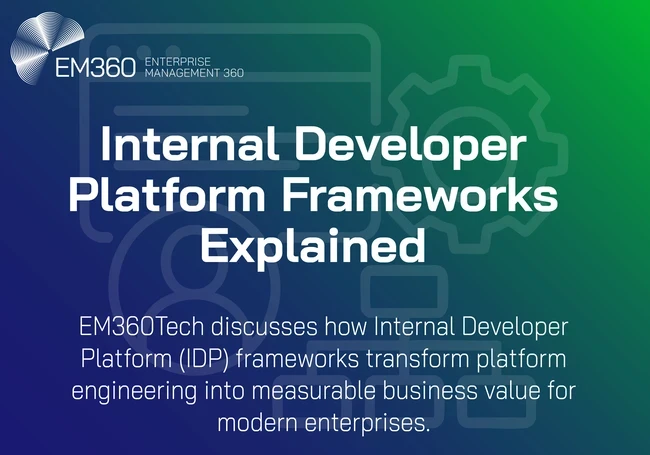
What Is an Internal Developer Platform Framework?
An Internal Developer Platform framework is the structured method your organisation uses to bring the platform together. It defines the layers, interfaces, policies, and feedback loops that turn a collection of tools into a product your developers can trust every day.
Think of the platform as the operational ecosystem. It includes the orchestrator that provisions environments, the automation that drives deployments, the identities and permissions that protect access, and the observability that keeps everyone honest. Think of the framework as the blueprint for how those parts fit and behave.
It sets standards, codifies golden paths, and maps responsibilities so teams can move quickly without negotiating every decision from first principles.
Good frameworks translate DevOps principles into repeatable workflows. They make self-service safe through policy automation. They reduce cognitive load by replacing ad hoc processes with templates, scorecards, and paved paths that reflect agreed standards. ad hoc
Vendors, cloud providers, and the open-source community all describe the same direction: an internal product that enables developers to manage environments, deployments, resources, and configurations through a consistent interface.
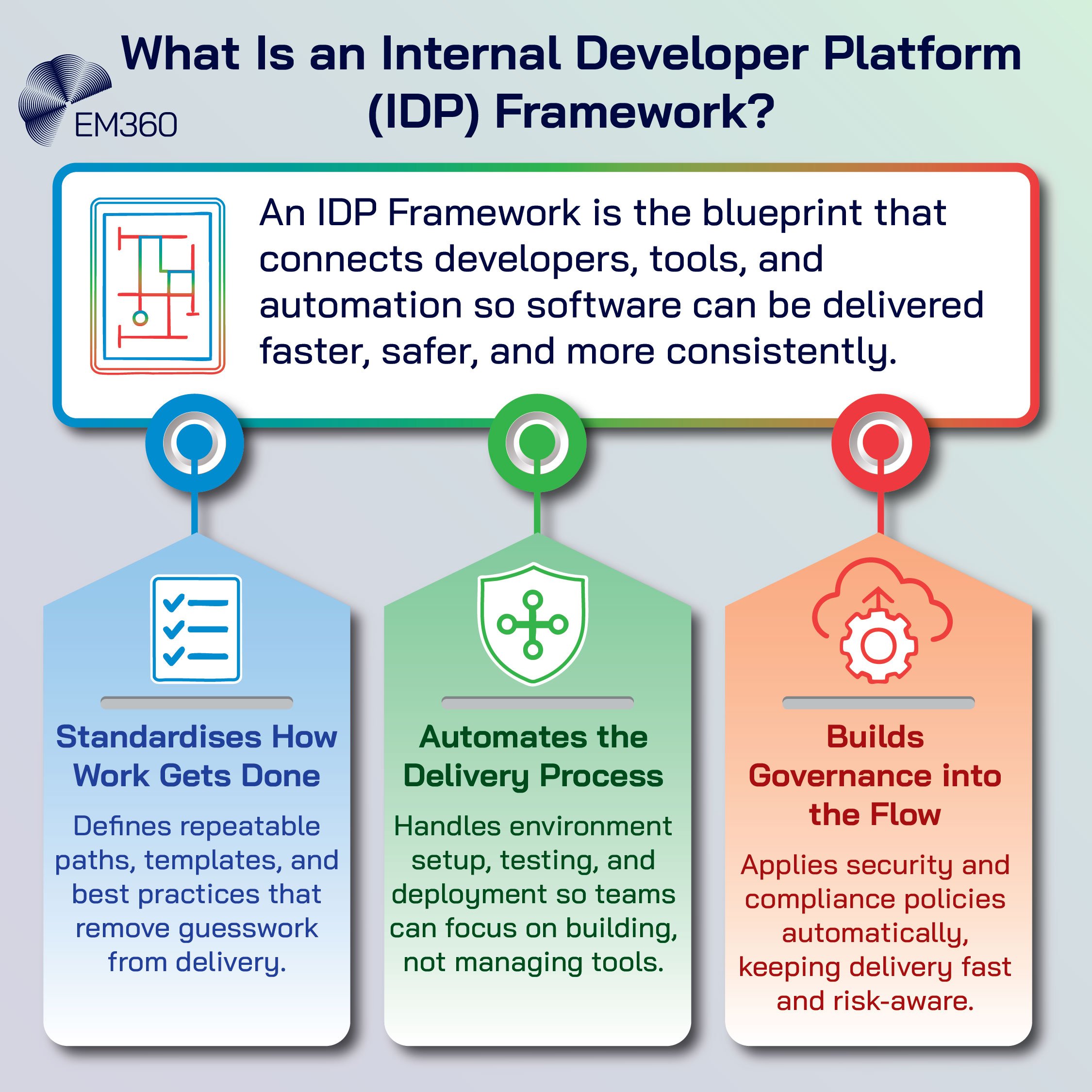
How IDP Frameworks Evolved from DevOps and Platform Engineering
DevOps introduced continuous integration and continuous deployment, with automation and a stronger relationship between development and operations. As systems grew, leaders recognised that culture and pipelines weren't enough. Teams needed a structured way to standardise the experience across many services and many squads.
That's where platform engineering stepped in.
The research record is clear on what matters. DORA’s 2024 report highlights platform engineering’s role in reliable software delivery and pairs it with user-centred practices that reduce friction and support stable priorities. Put simply, teams that remove waste and standardise delivery perform better.
Atlassian’s developer experience data puts numbers against the problem leaders are trying to solve and why a framework is the right tool for the job. The result is a shift from isolated tool choices to platform products, owned by a platform team, governed by a framework, and measured on outcomes rather than activity.
Core Components of an IDP Framework
An effective framework spans technology and governance. The technology pieces make work possible. The governance layer makes work safe, compliant, and repeatable.
- Platform orchestrator that automates environments, deployments, and resource configuration.
- Developer portal and service catalogue that expose self-service actions and service metadata through a single, usable interface.
- Guardrails and scorecards that codify policy, track standards, and nudge behaviour without blocking flow.
- Observability and feedback that make quality visible and improve both the product and the paths teams follow.
Cloud providers and vendors describe similar blueprints, with small differences in naming. What matters is that the framework joins these capabilities together and makes them easy for teams to consume.
1. The platform orchestrator – the control plane
The orchestrator is your engine room. It provisions environments, configures infrastructure and platform resources, and triggers deployments through pipelines that teams can understand and trust. The orchestrator enforces platform rules at the point of change, which is where policies do the most good.
It's also where you anchor infrastructure as code and GitOps so configuration is versioned, reviewable, and recoverable.
A well-run orchestrator supports multiple interfaces. A team can request an environment from a portal, run a template through a CLI, or push a change in that the orchestrator observes and applies. The interface may change, but the rules do not. This keeps delivery consistent across services, squads, and regions.
2. Developer portals and service catalogs – the interface layer
The portal is the front door to the platform. It gives teams a single place to discover services, understand ownership and dependencies, view scorecards, and run self-service actions. Backstage has become the best-known open-source option, with enterprise distributions such as Red Hat Developer Hub that add curation, support, and verified plug-ins.
That momentum signals a clear pattern: most organisations will not build this layer from scratch. They will adopt and extend a portal so the platform team can focus on the paths and policies that make the real difference.

It's important to keep one distinction in view. A portal is not the platform. It's the interface that sits above the orchestrator and exposes the parts your developers need. Conflating the two leads to disappointment because you can implement a portal and still lack the automation, policy, and integrations that deliver outcomes.
3. Guardrails, scorecards, and policy automation
If the orchestrator is the engine room and the portal is the front door, guardrails are the road markings. They keep teams within safe limits without turning every interaction into a request for permission.
In practice, this means policy as code, role-based access control, and scorecards that reveal whether a service meets agreed standards for security, reliability, and operational readiness. The trend is to move these controls into the platform product itself, rather than managing them as a separate spreadsheet or periodic audit.
Vendors are responding with scorecard features that integrate with telemetry and service metadata, so standards and evidence live in one place. Datadog’s Internal Developer Portal, for example, combines live observability with service ownership and scorecards to keep quality visible and current.
4. Observability, insights, and feedback loops
Frameworks are only as good as the feedback they capture. Observability connects platform actions to outcomes. If an upgrade to a golden path improves lead time, you should see it in deployment frequency, failure rates, or time to restore. If a policy slows teams unnecessarily, you should see that in cycle time.
Modern frameworks treat observability as a first-class concern. They integrate logs, metrics, traces, cost data, and incident information into the portal and the platform’s data model. Continuous improvement then becomes normal teamwork rather than an annual exercise.
This approach reflects both cloud provider guidance on implementation and independent research that ties platform engineering to measurable performance.
Why So Few Enterprises Are Ready to Scale Their IDP Frameworks
Platform engineering has momentum, but readiness is another story. Most enterprises are still early in translating that intent into structured practice. They have the talent, the tools, and the ambition — but not yet the cohesion. Frameworks are being discussed in boardrooms, not yet embedded in day-to-day workflows.
The reasons are mostly operational, not strategic. Many organisations still treat platform engineering as a collection of tools rather than a product with a defined lifecycle. Without a shared framework, each team builds its own patterns, templates, and deployment logic. The result is fragmentation disguised as progress — dozens of partial platforms instead of one coherent ecosystem.
Then there’s the scale problem. IDPs are meant to unify delivery across teams, environments, and cloud providers. That requires clean integration between infrastructure, CI/CD, policy, and observability layers. Most enterprises already have these components in place, but they live in silos — owned by different functions with competing priorities and disconnected feedback loops. The technical foundations exist; the framework that connects them does not.
Cultural inertia adds another layer of friction. Platform engineering works best when infrastructure is treated as a product and developers are its customers. That shift takes time and sponsorship. Without it, platform teams become tool administrators instead of service owners, and adoption stalls.
That is why enterprises are standardising their IDP frameworks. Standardisation reduces cognitive load, removes the delays that drain developer time, and gives leaders a consistent view of performance and risk. When teams can use a golden path to spin up a service, configure an environment, or deploy a change with confidence, delivery speeds up and errors go down.

Key Benefits for Infrastructure Leaders
Infrastructure leaders are measured on consistency, speed, and control — and the right IDP framework strengthens all three. By turning best practices into defaults, these frameworks give teams a faster, safer, and more predictable way to deliver software.
The benefits extend beyond developer convenience; they reshape how the organisation manages risk, tracks performance, and scales its digital operations.
Faster delivery with fewer surprises
Standardised paths for building, testing, and deploying reduce handoffs, rework, and inconsistent quality. DORA metrics, such as deployment frequency, lead time, change failure rate, and time to restore, give you a common language for improvement.
Governance that does not get in the way
Policy as code and role-based access keep teams within safe limits while preserving autonomy. Scorecards bring clarity without constant escalation.
Lower operating cost through sensible defaults
Templates capture approved patterns for infrastructure, security controls, and runtime configuration. Teams use them by default, which reduces support load and limits drift.
Better incident response
A single catalogue of services, owners, dependencies, and recent changes shortens triage. When the platform connects this metadata to telemetry, you get a clearer path from symptom to cause.
Improved retention and onboarding
Developers want to do meaningful work without fighting the platform. A reliable portal, a clear path to production, and sensible guardrails make that possible. The result is faster time to first contribution for new starters and a working environment that helps you keep the people you hire.
Building vs Buying: Which Model Fits Your Organisation?
There is no universal answer because the right model depends on your constraints and maturity. Most organisations mix both.
When buying makes sense
If your portal and catalogue needs are obvious, adopt a proven distribution rather than starting from zero. Backstage has a strong ecosystem, and Red Hat Developer Hub adds verification and enterprise support.
If your teams would benefit from scorecard-driven guardrails that connect to production signals, a managed portal with built-in telemetry can accelerate progress.
When building makes sense
If your differentiator lies in how the orchestrator applies rules and assembles environments, keep that logic under your control. You can still adopt a portal, but you own the paths, policies, and integrations that make your platform unique. This is common when you have strict security posture requirements or diverse environments across multiple business units.
A practical lens
Treat the portal and scorecards as productized layers you can buy. Treat the orchestrator, golden paths, and policy library as parts you shape to fit your organisation. Keep a clear contract between the layers so you can change one without breaking the others. That separation pays off when you want to swap a portal provider or adopt a new policy engine.

Implementing an IDP Framework That Works
Success depends on how you design for adoption and how you measure impact. The most effective programmes share a few patterns.
Treat the platform as a product: Assign a product manager. Identify users. Run discovery. Prioritise the paths that remove the most friction first. Publish a roadmap that shows where the platform will create value next. These are the habits that move adoption beyond advocacy.
Tie improvement to DORA metrics: Measure the same four indicators across services. Use them to guide investments in templates, automation, and policy. It keeps conversations grounded in outcomes rather than preferences.
Design for evidence: Bake auditability into the framework. Keep configuration in version control. Run policy checks in the path to production. Record who changed what and when. When a regulator or a risk committee asks for proof, you can show the work instead of recreating it.
1. Start with a Minimum Viable Platform (MVP)
Begin with a minimum set of paths that solve real problems. For many organisations, the fastest win is a path that spins up a standard service with a working pipeline, environment configuration, and the right access controls. Use it to prove value, then iterate.
Resist the urge to boil the ocean.
Each addition should reduce friction for a clear user group. Publish change notes and capture feedback through the portal so the platform evolves with the teams that use it. This incremental approach mirrors guidance from cloud providers that frame IDPs as internal products shaped by business goals and patterns, not one-time projects.
2. Align framework design to business goals
The right framework serves outcomes leaders already track. If your priority is faster feature delivery, invest in automated environment management, reliable pipelines, and template coverage. If your priority is risk reduction, invest in policy as code, service scorecards, and strong identity and access controls.
This is where platform KPIs help. Map golden paths to the metrics they should improve. Then publish baselines and targets. When you hit them, confidence grows. When you miss, the data shows you where to improve next.
3. Balance standardisation with flexibility
Standardise the boring, high-risk, or error-prone parts of delivery. Give teams freedom where innovation matters. That balance keeps adoption high. It also keeps the platform team out of the business of approving every exception. As more companies start using cloud-native solutions in different settings, it's important to have consistent practices, but it's also necessary to allow for differences when they make sense. A strong framework helps you do both.
The Future of IDP Frameworks
The pace of change in platform engineering shows no sign of slowing. As enterprise systems grow more complex, IDP frameworks are evolving to handle greater scale, deeper automation, and smarter decision-making.
The next generation of frameworks will focus less on building tools and more on orchestrating intelligence — turning real-time data, AI, and automation into continuous improvement.
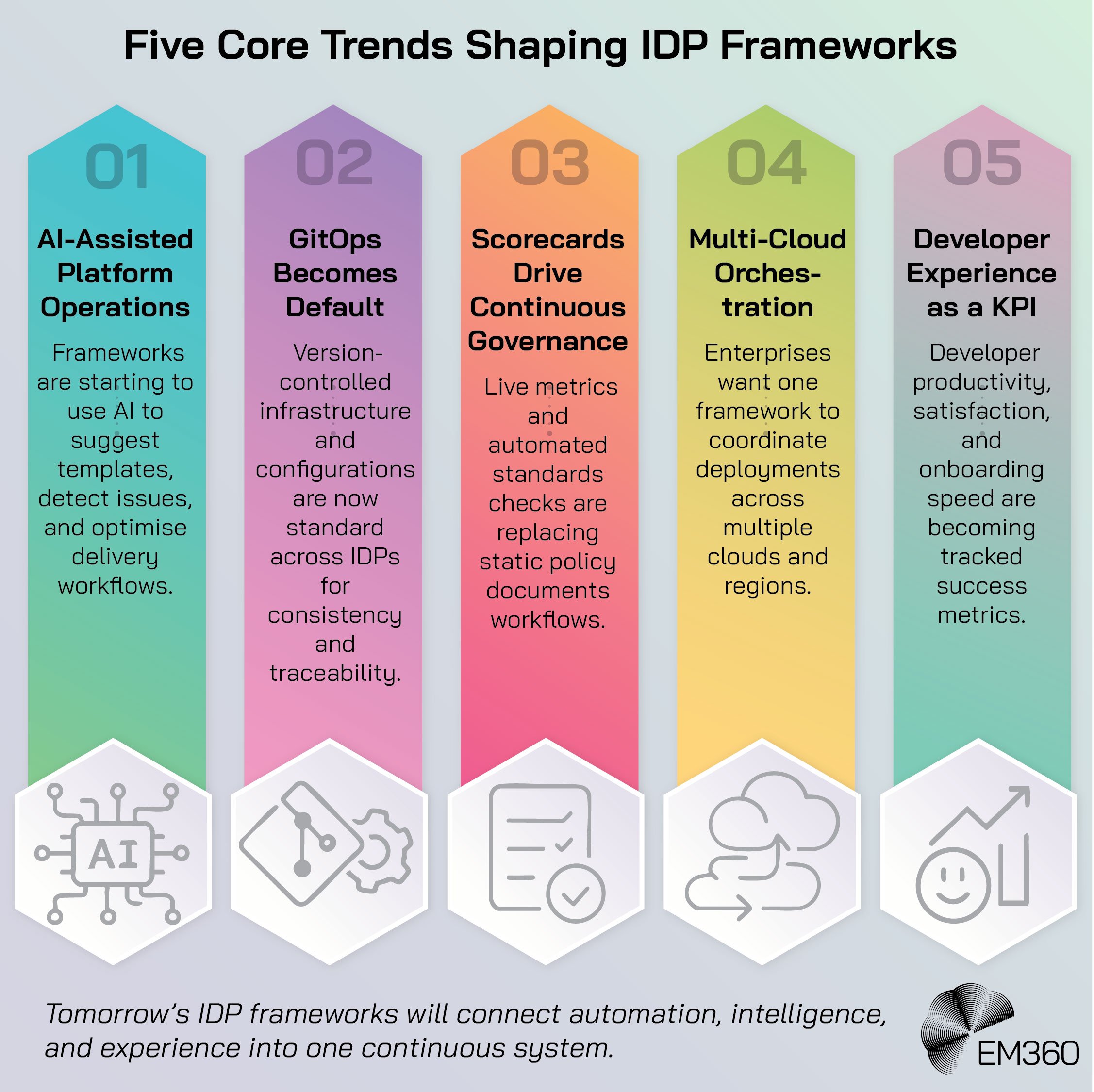
AI-assisted workflows
Expect more assistance with templating, incident analysis, policy checks, and knowledge retrieval. The research conversation already treats AI as a near-term contributor to platform and engineering outcomes. The goal is not to replace judgement but to automate the repeatable analysis that slows teams down.
Multicloud and hybrid orchestration
As organisations adopt multiple providers, frameworks will need clearer separation between platform rules and underlying infrastructure. The orchestrator becomes the constant, while the substrate varies by region or business unit.
Cloud-native surveys continue to report growth across providers and clusters, which raises the premium on consistent, -driven patterns.
Intelligent policy enforcement
Scorecards will mature from static thresholds to adaptive targets informed by telemetry. Instead of one rule for every service, thresholds will reflect risk, criticality, and recent change. Vendors are already moving in this direction by blending live production signals with service metadata in the portal.
Portal-plus becomes the baseline
Enterprises are adopting portal distributions rather than assembling the interface layer themselves. The work is now to connect those portals to orchestrators, templates, and policy engines that fit the organisation. That's good news for time to value, since the interface is often the longest and least differentiating part to build.
Final Thoughts: Frameworks Turn Platform Engineering into Measurable Value
Internal Developer Platform frameworks are how large organisations turn good intentions into delivery discipline. They standardise the work that should be standard, automate the parts that are better done by machines, and embed governance into the path rather than the queue.
When you do it well, developers recover time, leaders gain visibility, and the organisation ships higher-quality software with fewer surprises. The direction of travel is already set by the market and the research. The opportunity is to make it meaningful where you are.
If you are shaping your platform strategy and want to benchmark what good looks like, stay close to the teams building and running the work every day. The strongest frameworks reflect their reality.
EM360Tech continues to track the patterns that matter to infrastructure leadership and developer experience, with clear takeaways you can apply on Monday morning.


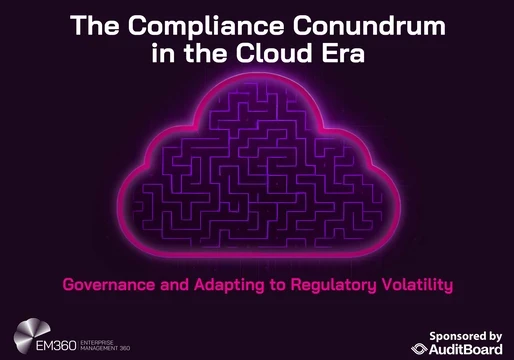

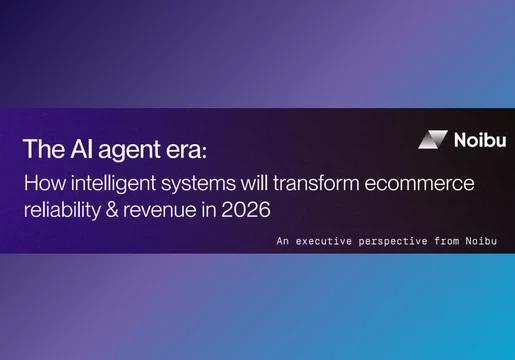


Comments ( 0 )